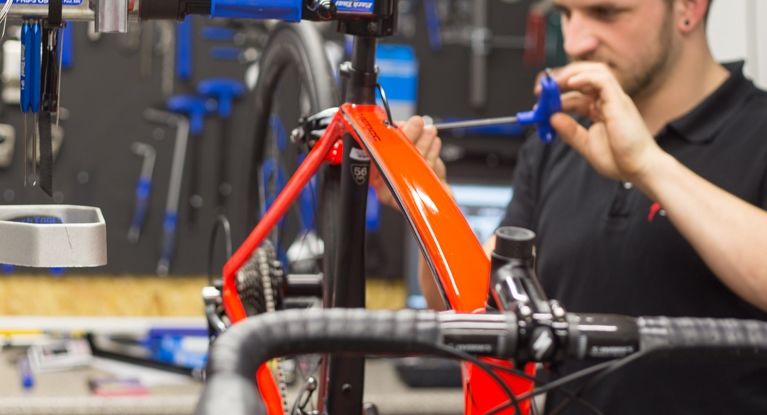
It would be great to be able to ride our bikes throughout the British winter, and then through a wet spring and into a, well, wet summer without having to do maintenance at all. In reality, our highly engineered and hugely evolved machines need a bit of love to keep their moving parts, and exotic materials in race condition. However, keeping on top of it will save you surprises and big mechanic’s bills. This is by no means a full list of all the maintenance you should do, but it is the most important ones. We’ll ignore things which can be covered by a quick visual inspection like tyre pressures and condition.
Checking Chain Wear
If you check your chain frequently using either the measuring method, or with a checker tool, you can save money on new cassettes. As chains wear, they wear the cassette too, the more a chain is worn, the more the cassette will wear. Therefore if you replace a chain before it is too worn, you can save having to buy a new cassette. A chain wear checker is a very simple measuring tool, which slots between the rollers on your chain, and measures what is erroneously called ‘stretch’ (it’s not actual stretch, but in fact wear). It will tell you straight away if you should replace your chain, or if it’s too late, at which point you will soon have to buy a cassette and chain.

Cleaning and Lubing Your Chain
Keeping your chain clean and lubed will save your chain from wearing as quickly, and save you from having to prematurely replace the chain due to rust. As you ride, on the road or the trail the lube either picks up dirt which helps wear your drive train, or the lube just washes off. Firstly, you should be cleaning your chain with a chain cleaning fluid so that it you can see the metal. Secondly you should be lubing the chain with the correct lube for the conditions - wet lube for winter, and well, wet lube for summer. If you’re lucky enough to be experiencing a dry spell in the UK, use dry lube. Dry lube will pick up less dirt than wet lube, but wet lube will actually stay on your chain when the conditions are less than tropical.

Checking Bearings on the Bottom Bracket and Headset
Standing astride the bike, hold just the front brake on tightly and rock the bike backwards and forwards, you should be checking to see if there is any movement coming from the head tube, and any slight knock, sound, or movement will mean that your headset is too loose, or the bearings are worn. Replacing that headset, or tightening it could save you buying a new frame because the movement in the headset has damaged the head tube.
The bottom bracket is as quick. Crouching by the side of the bike, and looking at the chainset face on like a clock, grip the crank firmly and push backwards and forwards like you were pulling a pint. You should feel no movement from the bottom bracket. If there is, you may need to tighten the bottom bracket or replace just the bearings. If you leave it, it could cost more.
Checking Brake Blocks/Pads
For both road rim blocks and road/mountain bike discs, replacing the stopping surface will reduce wear on either the rim or the disc rotors respectively, both are a more expensive repair. For disc brakes, remove the wheel, and if look at the pads, there should be a distinct layer of pad, before the steel backing plate. If there isn’t, get ‘em changed before they score your discs! For rim brakes, again remove the wheel and inspect the pads, make sure that there is a good amount of pad left, if there isn’t, replace it. If not, the backing plate will eat away at your rim, and you’ll have to replace the wheel/rim in no time. As well as saving money, you’ll enjoy safer and more efficient braking, which means that you can go faster!
Checking Wheel Bearings
Whilst there may be a slight lateral (side to side) flex in your wheels when you grip the rim and move it in that motion, there should be no noise, or even hint of a knocking. If there is, you either need to service the hubs or replace the sealed bearings within the hubs. If you catch it early enough you may get away with a service, if you leave it, you may end up damaging the hub shell and needing a new hub, or more likely these days, a new wheel.
BOOK A SERVICE >